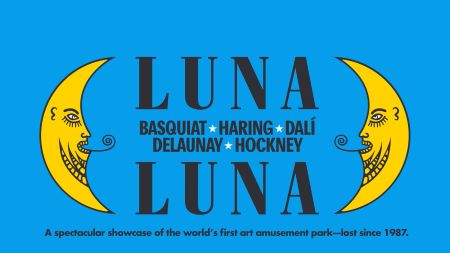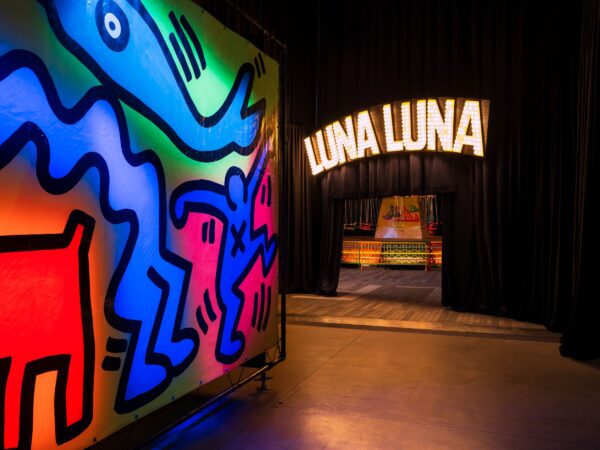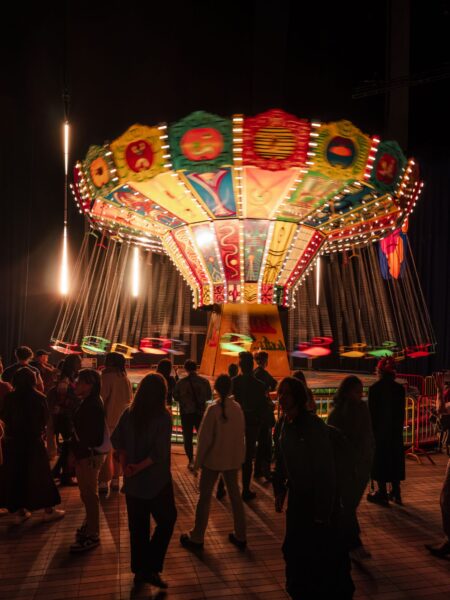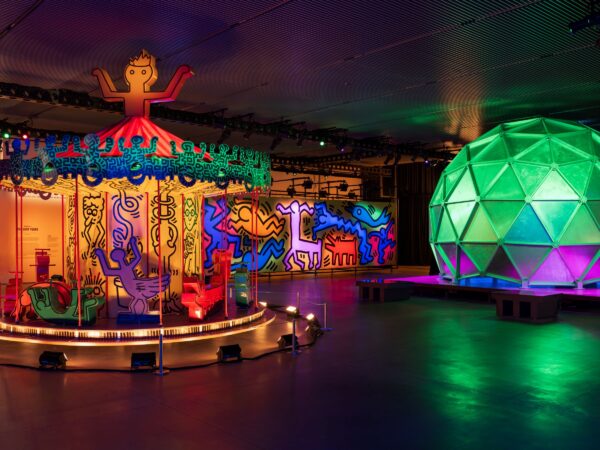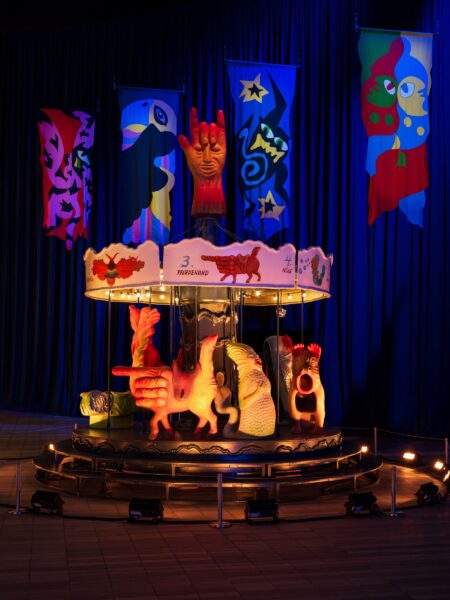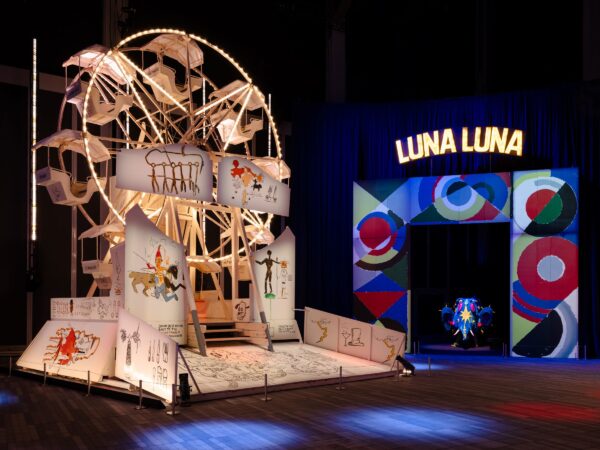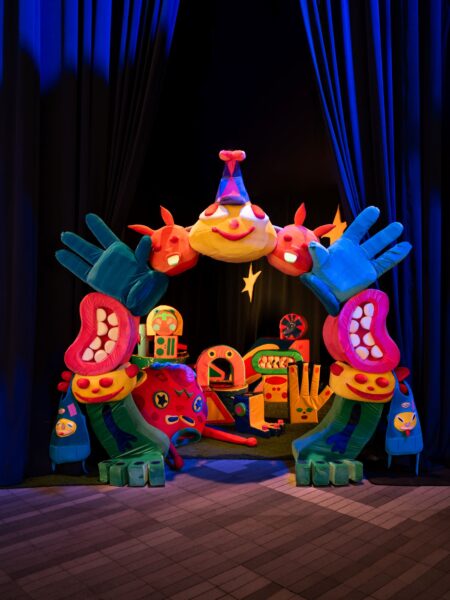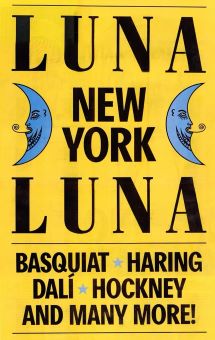CHE BELLA BELLA LUNA LUNA!
There is a whimsical and unmissable art event this winter, Luna Luna, a forgotten art amusement park with attractions made by a pantheon of renowned artists. The original Luna Park opened in 1903 on Coney Island and it had colorful rides illuminated by thousands of lights. Many other Luna Parks followed but none included the most prestigious art of the time. Luna Luna, conceived and produced in Hamburg in 1987 by artist André Heller, did. Heller inserted contemporary art into a traditional amusement park and invited everybody to enjoy it, especially people who had never walked into an art gallery before. By an unexpected turn of events, the park’s treasures languished in storage in Texas for 36 years. But in December 2023, Luna Luna: Forgotten Fantasy returned with an exhibition in Los Angeles. It’s now at The Shed in NYC until March 16.
Keith Haring‘s large Rectangular Tarps leads the way to the entrance, immediately evoking a cheery, childlike mood, something you need when you’re about to enter an amusement park. Haring’s iconic visual language, vivid and bold, brilliantly fuses vibrant energy with expressive social commentary on human struggle, and his archetypal characters seem to be in perpetual motion or interaction.
Once inside the large room, a carnival-like dreamscape, you find a Carousel with tri-dimensional versions of Haring’s characters in repetitive motion that is both playful and timeless. His art is deeply rooted in the aesthetics of 1980s graffiti and street culture but it is truly accessible to everybody. That universality makes him the most significant artist in Luna Luna because he fully adhered to its mission. The few children there were mesmerized by his kinetic characters, even if they did not understand the social messages on AIDS awareness, freedom, violence, and the fragility of life embedded in them.
To the left of Haring’s carousel, another magical attraction surprised me: Kenny Scharf’s Chair Swing Ride and Sculptures. Haring and Scharf were close friends who frequently collaborated but their works are very different; Scharf is a self-described Pop-Surrealist and this very large ride is delightfully chaotic, almost hallucinatory, adorned with colorful doodles and playful shapes. His unique, psychedelic, otherworldly creatures have influenced all modern cartoons; his sculptures for the ride, larger-than-life quirky characters originally placed on its top, are a heady mix of optimism and irreverence.
Arik Brauer‘s fantastical Carousel, right in front of it, has eight different characters—among them a butterfly, a she-wolf, a mermaid, and a hand-horse all in vivacious colors. They are abstract mythological figures filled with symbolism, a mix of Fantasy and realism, playful but unsettling. Roy Lichtenstein‘s Pavillion, with exterior panels painted by him and a glass labyrinth inside, is in style with his 1985 “Perfect/Imperfect” series. He used, as he often did, Ben-Day dots, a method adopted by illustrators to increase the tonal range in commercial printing.
Next to it, David Hockney’s Enchanted Tree, a cylindrical structure made of panels painted with green, blue, and red geometric trees; inside, there is a smaller second cylinder with similar panels. The title suggests that this is not just a tree but a magical being but I did not find it as whimsical and daring as other attractions. Certainly it is more interesting than Basquiat’s Ferris Wheel which seems an afterthought, a rushed work. Cartoonist Manfred Deix’s Palace of the Winds brought many laughs: a façade where different inappropriate characters farted or smelled flatulence with disgust, and a small screen that showed the original show, a concert where performers passed gas into microphones, accompanied by violins that played classical music.
There are many other interesting works by renowned artists; Salvador Dalí’s Dalídom, André Heller’s Wedding Chapel, Monika GilSing’s Wind Images, Daniel Spoerri‘s Crap Chancellery, are just a few of them. Plan to stay enough time to see each pavilion come to life because they all have a specific soundtrack. Philip Glass’s In the Upper Room: Dance IX and Miles Davis’s Tutu, two of the many unforgettable pieces of music, added a temporal and entrancing atmosphere to the exhibit, making Luna Luna the most interesting art show in New York right now. Do not miss it.
photos by Brian Ferry Courtesy of Luna Luna LLC
Luna Luna: Forgotten Fantasy
The Shed, Bloomberg Building, 545 W. 30th in Hudson Yards NYC
open Tues-Sun; entrance times vary
scheduled to end on March 16, 2025
for tickets ($25-$98), visit Luna Luna or The Shed
Vintage poster print designed by Keith Haring for the original Luna Luna experience in 1987. 33.1" x 23.4" On sale at the Luna Luna Shop for $955
